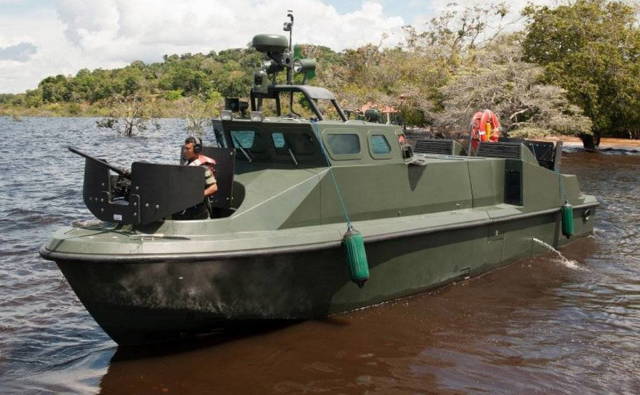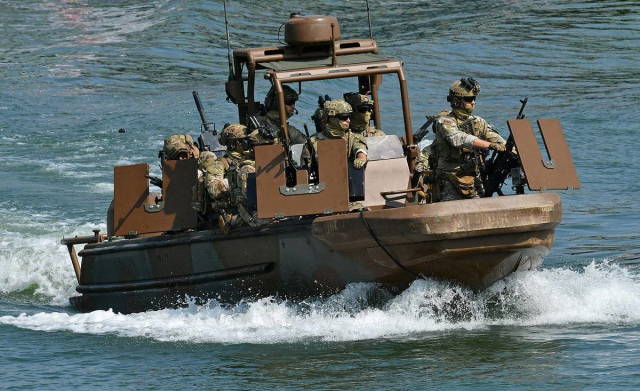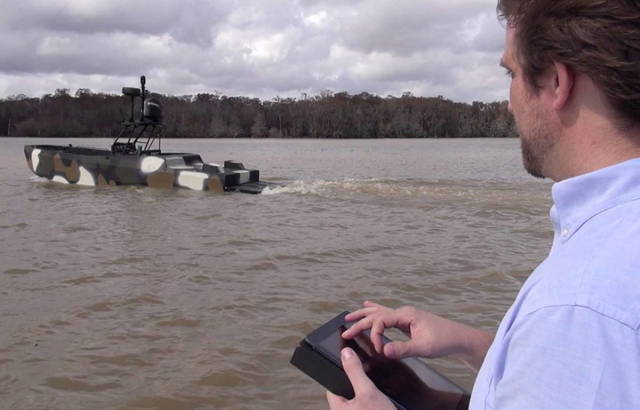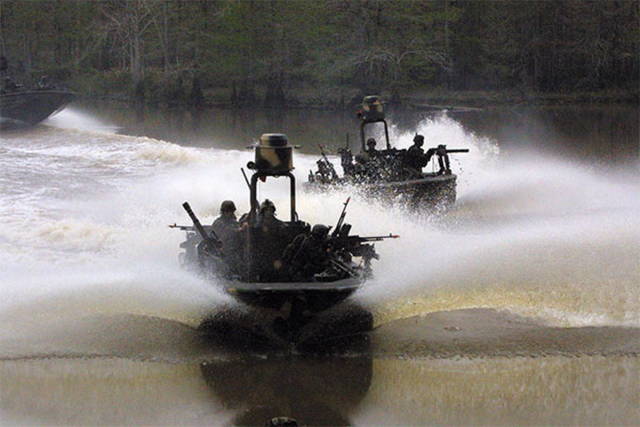As noted in the first part , in modern conditions, river operations are becoming increasingly important in regions where economic and social life develops along river basins. The international market continues to see the spread of water transport technologies that can support the conduct of combat operations on rivers. According to Shehraze SHAH, Chief Executive Officer of Swiftships (Morgan City, Louisiana, USA), the riverboat market continues to grow steadily in countries with extensive inland waterways.
Referring to market opportunities in Latin America, South and East Asia, as well as the Middle East, Shah explained how the armies of these countries continued to develop towards the development and procurement of fully functioning vessels with an organic coast-to-coast navigation capability: "This move reduces their reliance on the major navies for withdrawal, evacuation, raids, and security-related operations, inside and along inland and protected waterways."

«In Central America and the Middle East, there is now a growing interest not only in securing these waterways, but also in using them as channels for deep covert operations on land. Along such waterways, river vessels provide greater mobility than land vehicles over rough terrain. Therefore, we believe that the need for faster and more maneuverable river vessels will only grow, and that in the coming years, the US Army and other armed forces will seek and develop these capabilities, " he urged.
Sh.Shah illustrated his comments with several contracts in Latin America for water vessels to support military river operations.
Funds for river operations in Latin America
So, the Colombian Navy received a complete set of nine Lancha Patrullera De Rio (LPR) 40 MKII river boats for marine Corps teams. The LPR 40 MKII, produced by COTECMAR, is made of composite materials to provide protection against stranding, as well as the ability to carry a special set of navigation, reconnaissance, target designation and communication (C4ISTAR) equipment.

Lancha Patrullera De Rio (LPR) 40 MKII River Boat
According to the manufacturer, the 12.7 m long vessel has a full displacement of 12.5 tons and can move at a speed of more than 35 knots. The vessel is powered by a diesel engine and a pair of Tipo water cannons and has room on deck to carry up to six people. The set of weapons includes two large-caliber 12.7-mm and two medium 7.62-mm machine guns. Deliveries were completed during 2017.
At the same time, to support river operations in the Amazon basin, the Brazilian army in October 2017 adopted the MRCD 1250 (Military Riverine Craft Diesel) vessel from ASIS Boats. Sources in the Armed Forces of the country reported that the detachment will be based in Manaus (Amazonia). The MRCD 1250 has a top speed of up to 80 mph and can carry 25 people and up to 4,800 kg of cargo. The rigid hull inflatable boat (RHIB type) can be reinforced according to the NIT III standard with the integration of Dyneema ballistic protective panels to cover the landing party and crew. The vessel is suitable for air transport by planes and helicopters.

MRCD 1250 from ASIS Boats
According to Sh. Shah, the most important requirements for river vessels are their mobility, firepower and security. According to him, the variants of the weapons kits can range from stabilized remotely controlled crew light, medium and heavy machine guns and automatic grenade launchers to their unstabilized alternatives.
"To help meet these basic requirements, the positioning, navigation and communication system packages-together with active / passive sensors-are valuable additions. These packages, which ensure compatibility between platforms and systems, are provided by the shipbuilder or the integrator, or are added by the customer, " Sh.Shad continued.
Swiftships continues to offerthe Special Operations Craft-Riverine ( SOCR) Anaconda on the international market. The vessel can be loaded into the C-130 Hercules tactical military transport aircraft. The model is designed as a river assault ship, which allows you to perform tasks of reconnaissance and protection of troops.
SOCR "Anaconda" produced by Swiftships
According to the manufacturer, SOCR is able to work in both fresh and seawater. The vessel is equipped with a pair of electronically controlled diesel engines and a pair of Rolls Royce FF-Series water cannons. The maximum speed is more than 50 knots. In addition to the crew, the craft is capable of carrying up to 14 military personnel and carrying five weapons systems that provide 360-degree deck coverage. The model is designed with a low profile, which makes it easier to hide along the banks of the river. Its design allows you to perform sharp turns at high speed, and the strength of the body – " cut " sand banks and floating debris.
"SOCR has sufficient space and payload capacity for armor, weapons, and personnel to meet the payload requirements for all mission profiles," Shah added.
French Alternative
In March 2017, the French Special Operations Command (COS)presented its latest River battle boat ( EFC ) at the Special Operations Forces Innovation Network Seminar (SOFINS) in Camp de Paris, France.

River Battle Boat (EFC)
The boat will enter the arsenal of the 1st Marine Parachute Regiment. The 9.1 m long vessel is powered by a pair of 300 hp Mercury outboard engines and provides the crew with a maximum speed of 45 knots. It is planned that COS will receive a total of 3 EFCS, which are an upgraded version of the river ship Pirenn ERF1 Styx, which was first presented at Euronaval in 2014. As part of the cooperation program with COS, after evaluating the capabilities of the ERF1 Styx, the ship was finalized. Upgrades include increased deck space and the use of carbon-epoxy resin instead of polyester to reduce weight.
At the SOFINS exhibition, the ship was demonstrated with improved weapons: two medium 7.62 mm FN MAG machine guns and a large-caliber 12.7 mm FN M2 machine gun. Additionally, a 40-mm automatic grenade launcher can be installed in the modular weapon mounts.
The unmanned future
SOCR "Anaconda" can also be used as an unmanned surface vessel (USV). Switships is in the process of developing and integrating artificial intelligence (AI) into its navigation system to achieve full autonomy. «We expect this technology to become the standard for deployment in the medium term. In the long term, we are experimenting with different body shapes, sizes, and new powerplants. Improvements of this kind will expand the range of Anaconda's capabilities to cover a broader set of operational requirements. We are also seeing efforts to integrate the use of small UAVs and to improve interoperability within what we know is an increasingly network-centric combat environment, " Shah concluded.

The uninhabited version of SOCR " Anaconda»
The UAV plans to further strengthen its support for river vessels through the developmentof the Maritime Canister-Launched Small Unmanned Aerial System ( MCLSUAS), which is currently being developed by Lockheed Martin in cooperation withthe US Combat Terrorism Technical Support Office (CTTSO).
The MCLSUAS system is designed for use by MTRS operating in the coastal zone and river basins. The system should be able to launch, use and recover from under water in the interests of conducting ground reconnaissance. According to sources associated with the US Navy Special Operations Command (NSW), such capabilities can be used by groups of combat swimmers brought to the area of interest by river transport. Currently, SWCC NSW teams are using a catapult-launched ScanEagle from the US manufacturer Insitu to provide ISTAR capabilities on board SOCR.
According to a representative of Lockheed Martin, the MCLSUAS solution includes a Vector Hawk UAV, which provides a maximum autonomy of 40 minutes and a maximum speed of 50 knots. In addition, the drone is able to stay on the surface of the water for 30 minutes after splashing.
Based on the materials of the NAVAL FORCES magazine


